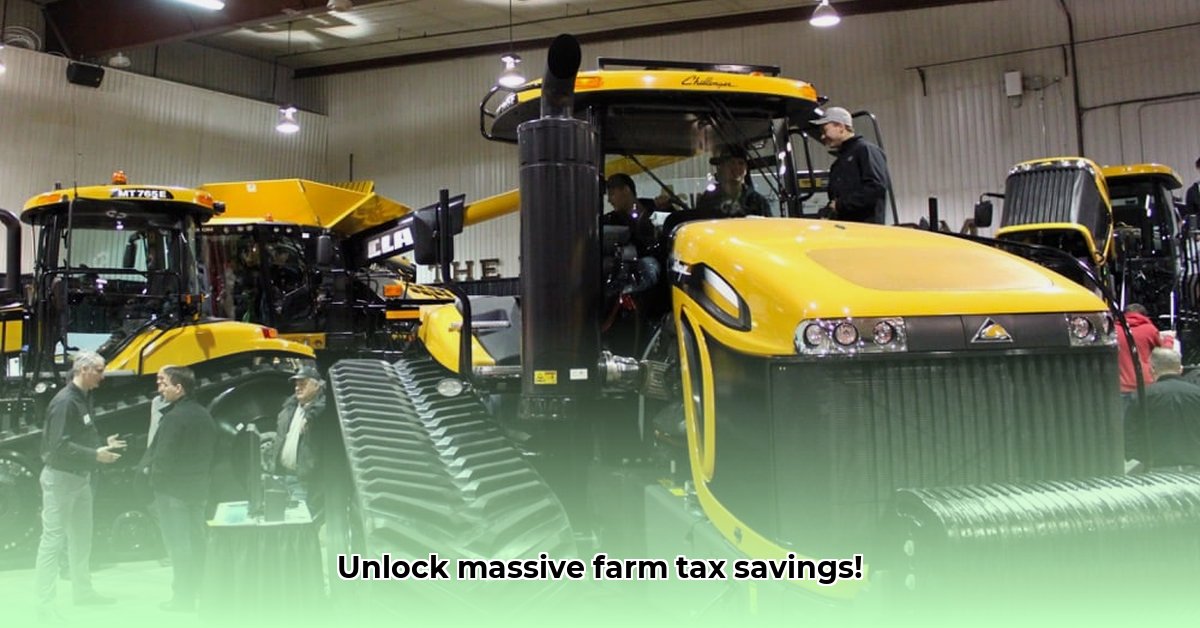
Understanding Tractor Depreciation and its Tax Implications
Owning a farm is a significant investment, and your tractors represent a substantial portion of that investment. Understanding tractor depreciation is crucial for maximizing your tax benefits and ensuring the long-term financial health of your operation. Depreciation, in simple terms, is the accounting method that reflects the decrease in value of your assets over time due to wear and tear, obsolescence, or other factors. For farmers, this translates to valuable tax deductions. Let's explore how this works in the context of sustainable agriculture. For accurate valuations, check out this helpful resource on used tractor values.
One common method for calculating depreciation is the Modified Accelerated Cost Recovery System (MACRS), a US tax depreciation system. Under MACRS, tractors are typically classified as 5-year property, meaning you can deduct a larger portion of their cost in the early years of ownership. This can significantly improve your short-term cash flow. But are you maximizing its potential?
Choosing the Right Depreciation Method: Straight-Line vs. Declining Balance
There's more than one way to skin a cat—or depreciate a tractor. Two primary methods exist: straight-line and declining balance.
Straight-Line Depreciation: This method evenly distributes the cost of the tractor over its useful life. It's simple to calculate and provides predictable deductions each year. While straightforward, it might not be the most tax-efficient approach in the short term.
Declining Balance Depreciation: This approach allows for larger deductions in the early years of ownership, which can boost your cash flow when you need it most. However, this means smaller deductions in later years. The 150% and 200% declining balance methods offer varying degrees of accelerated depreciation.
Which method is better? The optimal choice depends on your individual financial circumstances, income projections, and long-term financial goals. A tax professional can help you determine the most beneficial option for your specific situation. Have you considered the implications of each method for your farm's overall financial picture?
Section 179: A Potential Tax Booster
Section 179 of the Internal Revenue Code provides a powerful tool for farmers looking to maximize their tax savings. This section allows you to potentially deduct the full cost of certain qualifying equipment—including your tractor—in the year of purchase, up to a specified limit. This can significantly reduce your tax liability, especially when purchasing new equipment. However, it's important to consult with a tax professional to ensure you meet all the requirements and understand any limitations. Is Section 179 the right strategy for your farm's current financial standing?
Long-Term Planning and Tractor Depreciation: Think Ahead
Effective tax planning isn't a one-year event; it's a long-term strategy. Consider the entire lifespan of your tractor and your farm’s anticipated financial trajectory. This holistic approach will help you choose the depreciation method that best aligns with your long-term goals. Remember to factor in potential government grants, subsidies, and other financial incentives that might further lower your tax burden. Are you proactively considering future tax implications when making equipment purchasing decisions?
Tracking and Record-Keeping: The Importance of Good Documentation
Meticulous record-keeping is paramount. Maintain comprehensive records of all expenses associated with your tractor, including purchase documentation, maintenance, repairs, and any other relevant details. This detailed documentation is not just good practice; it's essential for accurate depreciation calculations and for demonstrating compliance during a tax audit. By doing so, you safeguard your farm from potential financial penalties and demonstrate responsible tax management. Have you established a robust system for tracking all relevant financial information related to your farm equipment?
Tax Professionals: Your Partners in Smart Farming
Navigating the complexities of tax law, especially concerning agricultural depreciation, can be overwhelming. A qualified tax professional specializing in agriculture can provide invaluable guidance in choosing appropriate depreciation methods, identifying other potential deductions and credits, and ensuring compliance with changing tax regulations. They can also help you understand and leverage programs like Section 179 and bonus depreciation to maximize your tax savings. This professional expertise is an investment in the long-term financial health of your farm. What questions are you still pondering about farm equipment depreciation and tax planning?
Risk Mitigation: A Look at Potential Challenges
While effective depreciation planning offers many benefits, potential risks exist. Let's examine some common challenges:
| Risk Factor | Probability | Impact | Mitigation Strategy |
|---|---|---|---|
| Choosing the Wrong Depreciation Method | Medium | Medium | Consult a tax professional; create realistic financial projections. |
| Tax Law Changes | Medium | High | Stay informed about tax updates; work with a tax professional who stays abreast of changes. |
| Failing to Report Expenses Correctly | Low | Medium | Maintain detailed records; have them reviewed by an accountant regularly. |
| Missing Out on Tax Credits | Low | Medium | Actively research relevant credits; consult with tax experts. |
Proactive risk management significantly enhances your farm's operational efficiency and financial stability.
How to Optimize Farm Equipment Depreciation for Sustainable Agriculture Practices
Key Takeaways:
- Mastering depreciation methods (straight-line, MACRS, declining balance) is crucial for effective tax planning.
- Precise asset classification directly impacts depreciation periods and allowable tax deductions.
- Section 179 expensing and bonus depreciation strategies can significantly enhance immediate tax benefits.
- Balancing accelerated depreciation’s short-term gains with long-term financial implications is crucial for sustainable farming.
- Technological advancements necessitate adapting depreciation schedules, influencing long-term financial planning.
- Proactive planning is key to managing asset disposal, upgrades, and potential trade-ins.
Remember, responsible financial management is the cornerstone of a successful and sustainable farming operation. Utilizing this guide and seeking professional advice will optimize your tax strategy and secure the long-term financial health of your farm. What steps will you take to implement these strategies immediately?